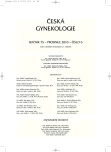Functionality of pelvic floor in patients after vaginal and abdominal hysterectomy, valuation by EMG-Biofeedback according to Perfect Scheme
Authors:
M. Hagovská; P. Takáč
Authors‘ workplace:
V spolupráci s Kúpeľným zariadení Liptovské liečebné kúpele Lúčky, a. s.
; Klinika fyziatrie balneológie a liečebnej rehabilitácie LF UPJŠ a FN L. Pasteura, Košice, prednosta doc. MUDr. P. Takáč, PhD.
Published in:
Ceska Gynekol 2010; 75(6): 540-546
Overview
Objective:
Our research deals with the efficiency of rehabilitation in patients after vaginal and abdominal hysterectomy. The activation of pelvic floor muscles has been evaluated and comparison of individual parameters according has been carried out. Also the occurrence of incontinence has been assessed.
Subjects consisted of 66 women, out of which there were 21 women after vaginal hysterectomy and 45 women after abdominal hysterectomy.
Type of study:
Prospective experimental study.
Methods use:
EMG – biofeedback has been used for the evaluation of the functionality of pelvic floor according to Perfect Scheme. For the quantification of leaked urine one hour PW test has been used.
Rehabilitation methods:
We applied the individual exercise on strengthening and relaxation of pelvic floor muscles with the aid of repeated, selective voluntary contractions or relaxation of pelvic floor muscles conducted two times a week, with the duration time of 15 minutes. Group exercise on strengthening and relaxation of pelvic floor muscles conducted two times a week, with the duration time of 30 minutes. Biofeedback (EMG-Module) as a therapeutic method was applied.
Results:
In patients after vaginal hysterectomy there was a higher occurrence of incontinence than in women after abdominal hysterectomy. In both groups a significant increase in pelvic floor muscle strength has been achieved after the therapy. In both of these groups there was no statistically significant relaxation of m. rectus abdominis after the therapy. The patients after abdominal hysterectomy had more statistically significant relaxed abdomen muscles before treatment than patients after vaginal hysterectomy. It means, that performed exercise in the right manner, with reduction of intra abdominal pressure. We suppose that this phenomenon may be related to the higher percentage of occurrence of incontinence in patients after vaginal hysterectomy.
Key words:
vaginal and abdominal hysterectomy, stress urinary incontinence, pelvic floor muscle training (gymnastics), biofeedback.
Sources
1. Bo, K., Sherburn, M. Evaluation of female pelvic - floor muscle function and strength. Phys Ther, 2005, 85, 3, p. 269–282.
2. Bouda, J. In Macků, F., a kol. Kompendium gynekologických operací. Praha: Grada publishing, 1995, 200 s.
3. Dannecker, C., Wolf, V., Raab, R., et al. EMG – biofeedback assited pelvic floor muscle training is an effective therapy of stress urinary or mixed incontinence: a 7 year experience with 390 patients. Gynecol Obset, 2005, DOI 10.1007/s 00404 – 005 -0011 – 4.
4. Dicker, RC., Greenspan, JR, Strauss, LT., et al. Complication of abdominal and vaginal hysterectomy among women of reproductive age in the United States. Am J Obset Gynec, 1984, 144, p. 841–846.
5. Ellstrom Engh, MA., Otterlind, L, Stjerndahl, JH., Lofgren, M. Hysterectomy and incontinence: a study from the Swedish national register for gynecological surgery, Acta Obstet Scand, 2006, 85, 5, p. 614–618.
6. Holub, Z. Úloha laparoskopickej hysterektómie v chirurgickej liečbe chorôb ženského reprodukčného systému. Praha: Galén, ed. Alma Mater,2000.
7. Holub, Z., Kužel, D., a kol. Minimálně invazivní operace v gynekologii. Praha: Grada publishing, 2005, s.107.
8. Johnson, N., Barlow, D, Lethaby, A., et al. Methods of hysterectomy: systematic review and meta-analysis of randomised controlled trials. BMJ, 2005, 330, 7506, p. 1478.
9. Kolařík, D. Konzervativní léčba v urogynekologii. In Halaška, M., a kol. Urogynekologie. Praha: Galén, 2004, s. 75–80.
10. Laycock, J., Jerwood, D. Pelvic floor asssessment: the P.E.R.F.E.C.T. scheme. Physiotherapy, 2001, 87, p. 631.
11. Ľubušký, M., Machač, Š., Ľubušký, D., et al. Hysterektomie na olomoucké klinice v letech 1989 - 2002: vývoj v indikačním spektru a operačním přístupu. Čes Gynek, 2004, 69 2, s. 125‑128.
12. Mayne, CJ., Hilton, P. Short apd test: method and comparison with one - hour test. Neurourol Urodyn, 1988, 7, 5, p. 443–445.
13. Pakbaz, M., Mogren, I., Löfgren, M. Outcomes of vaginal hysterectomy for uterovaginal prolapse: a population-based, retrospective, cross-sectional study of patient perceptions of results including sexual activity, urinary symptoms, and provided care.This is an Open Access article distributed under the terms of the Creative Commons Attribution License (http://creative commons.org/licenses/by/2.0,2009).
14. Neumann, PB., Grimmer, KA., Deenadayalan, Y. Pelvic floor muscle training and adjunctive therapies for the treatment of stress urinary incontinence in women: a systematic rewiew. BMC Womens Health, 2006, 6, p. 11.
15. Nieboer, TE., Johnson, N., Lethaby, A., et al. Surgical approach to hysterectomy for benign gynaecological disease. Cochrane Database of Systematic Reviews 2009, Issue 3. Art. No.: CD003677. DOI: 10.1002/14651858.CD003677.pub4.
16. Štěpán, J. jr., Kališ, V., Novotný, Z., et al. Vliv abdominální a laparoskopicky asistované vaginální hysterektomie na močovou inkontinenci. Čes Gynek, 2006, 71, 6, s. 438–445.
17. Tayrac, R., Chevalier, N., Chauveaud-Lambling, GA., Fernandez, H. Is vaginal hysterectomy a risk factor for urinary incontinence at long-term follow-up? Eur J Obstet Gyn Reprod Biol, 2007, 130, 2, p. 258–261.
18. Zábranský, F. In Holub, Z., Kužel, D., a kol. Minimálně invazivní operace v gynekologii. Praha: Grada publishing, 2005, 117 s.
Labels
Paediatric gynaecology Gynaecology and obstetrics Reproduction medicineArticle was published in
Czech Gynaecology

2010 Issue 6
Most read in this issue
- Vulvodynia and the possibility of its management
- Operation procedures in female sterilisation
- Asherman’s syndrome II – therapy, methods of guidance, prevention of readhesion processs, complications and results of therapy
- Nalbuphine at maternal analgesia
